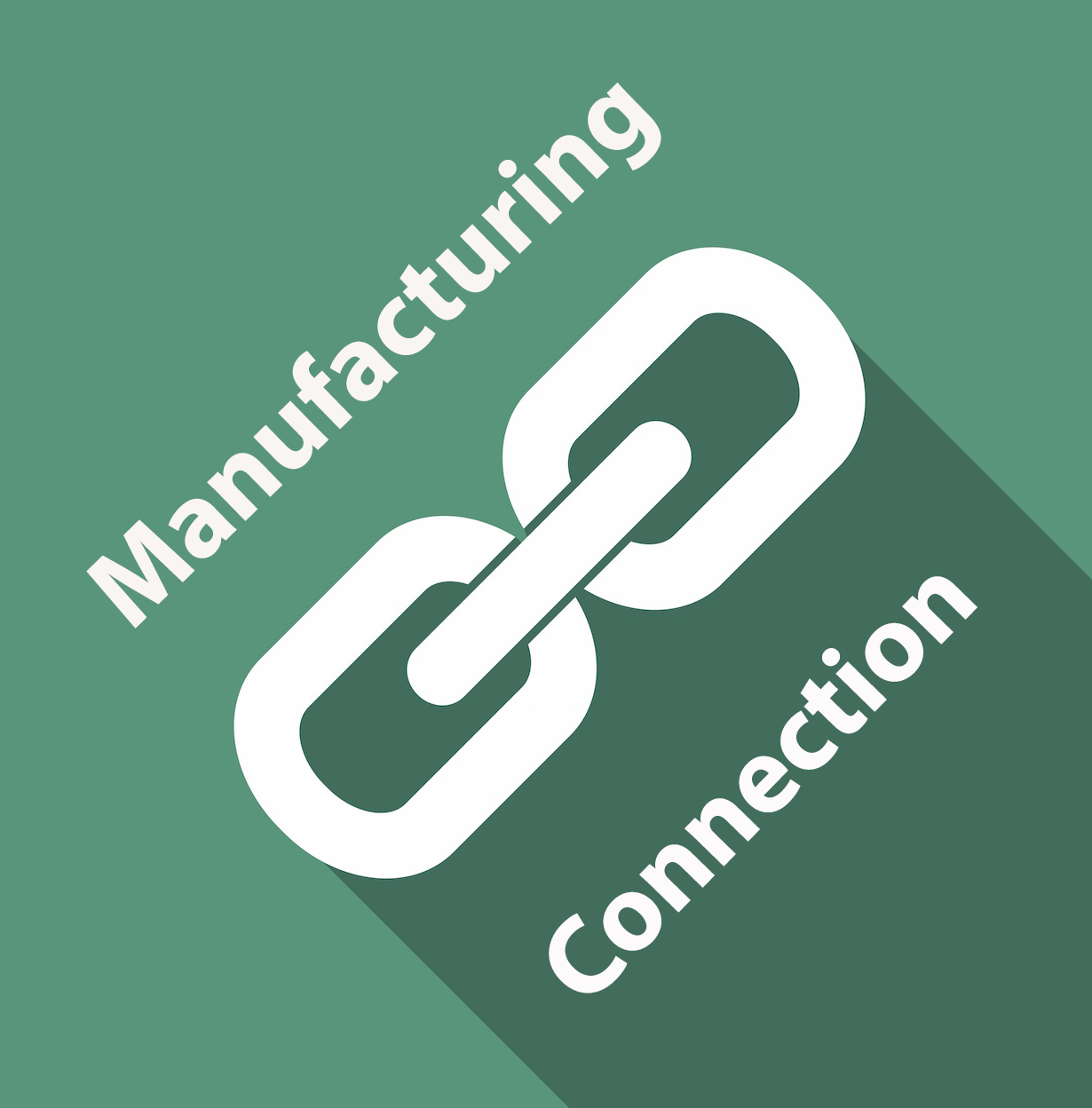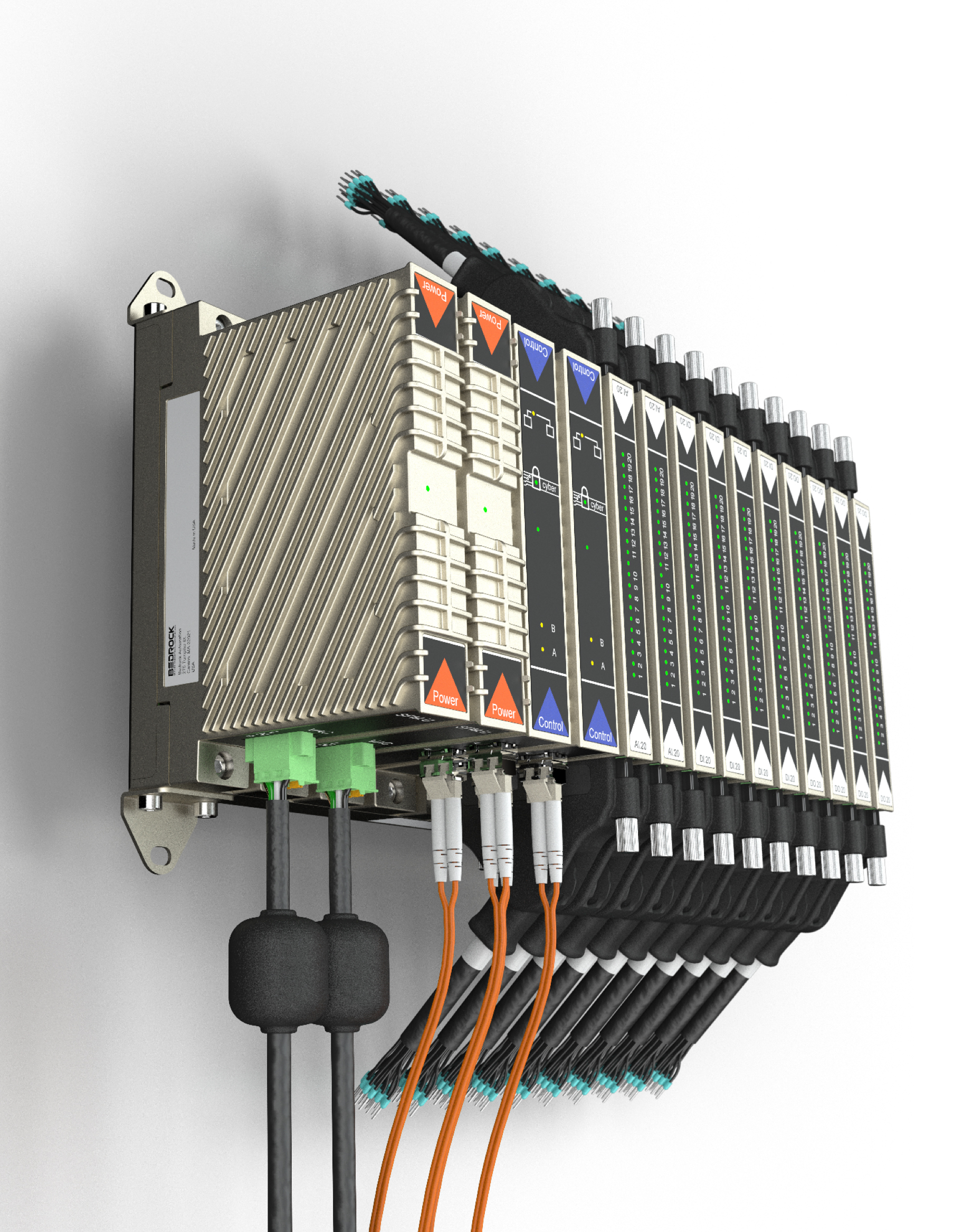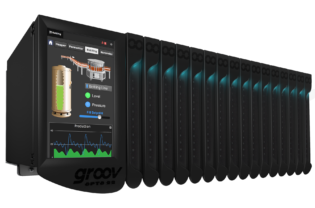
by Gary Mintchell | Oct 22, 2019 | Manufacturing IT, Software
Inductive Automation has selected the recipients of its Ignition Firebrand Awards for 2019. The announcements were made at the Ignition Community Conference (ICC), which took place September 17-19. I get to see the poster displays and chat with the companies at ICC. I love the technology developers, but it’s fascinating to talk with people who actually use the products.
[Disclaimer: Inductive Automation is a long-time and much appreciated sponsor of The Manufacturing Connection. If you are a supplier, you, too, could be a sponsor. Contact me for more details. You would benefit from great visibility.]
The Ignition Firebrand Awards recognize system integrators and industrial organizations that use the Ignition software platform to create innovative new projects. Ignition by Inductive Automation is an industrial application platform with tools for the rapid development of solutions in human-machine interface (HMI), supervisory control and data acquisition (SCADA), manufacturing execution systems (MES), and the Industrial Internet of Things (IIoT). Ignition is used in virtually every industry, in more than 100 countries.
“The award-winning projects this year were really impressive,” said Don Pearson, chief strategy officer for Inductive Automation. “Many of them featured Ignition 8 and the new Ignition Perspective Module, both of which were released just six months ago. We were really impressed with how quickly people were able to create great projects with the new capabilities.”
These Ignition Firebrand Award winners demonstrated the power and flexibility of Ignition:
- Brock Solutions worked with the Dublin Airport in Ireland to replace the baggage handling system in Terminal 2. The new system has 100,000 tags and is the largest Ignition-controlled airport baggage handling system in the world.
- Corso Systems & SCS Engineers partnered on a pilot project for the landfill gas system of San Bernardino County, California. The pilot was so successful, it will be expanded to 27 other county sites. It provides a scalable platform with strong mobile capabilities from Ignition 8 and Ignition Perspective, plus 3D imaging from drone video and virtual reality applications.
- ESM Australia developed a scalable asset management system to monitor performance and meet service requirements for a client with systems deployed all over Australia. The solution leveraged Ignition 8, Ignition Perspective, MQTT, and legacy FTP-enabled gateways in the field.
- H2O Innovation & Automation Station partnered to create a SCADA system for the first membrane bioreactor wastewater treatment plant in Arkansas. The new system for the City of Decatur shares real-time data with neighboring water agencies as well as the mayor.
- Industrial Networking Solutions created a new oil & gas SCADA system in just six months for 37 sites at ARB Midstream. The solution included hardware upgrades, a new control room, and a diverse collection of technologies with cloud-hosted SCADA, MQTT, Ignition Edge, and SD-WAN.
- MTech Engineering developed an advanced real-time monitoring and control system for the largest data center campus in Italy. The project for Aruba S.p.A. had to work with huge amounts of data — and was done at a much lower cost than was possible with any other SCADA solution.
- NLS Engineering created a single, powerful operations and management platform for more than 30 solar-power sites for Ecoplexus, a leader in renewable energy systems. The solution provided deep data acquisition, included more than 100,000 tags, and led to the creation of a platform that can be offered to other clients.
- Streamline Innovations used Ignition, Ignition Edge, Ignition Perspective, and MQTT, to facilitate the automation of natural gas treating units that convert extremely toxic hydrogen sulfide into fertilizer-grade sulfur. The solution increased uptime, reduced costs, and provided access to much more data than Streamline had seen previously.

by Gary Mintchell | Oct 4, 2019 | Asset Performance Management, Manufacturing IT, Software
I guess I did attend the last GE software conference Minds + Machines. However, the reconstituted and independent GE Digital recently held a user conference where it announced a number of upgrades to its IIoT software. These are firmly within the current trends of connecting and mobility.
The product updates include:
- Predix Essentials, which makes it easier for industrial companies to connect, visualize and analyze their data
- Asset Answers, which helps customers to understand the competitive potential of Asset Performance Management (APM) software
- Webspace 6.0, a new HTML5 interface that seamlessly brings automation data to operators across any mobile device
Edge-to-Cloud Accessibility
Predix Essentials is an easy-to-use SaaS solution, helping companies connect to disparate data sources, monitor operations, and leverage edge-to-cloud predictive analytics–reducing time-to-value for operational teams looking to reduce waste, lower costs, and increase performance.
Developed in partnership with a number of customers, including silicon chip manufacturer Intel, Predix Essentials is a natural first step for industrial businesses looking to leverage the power of cloud-based Industrial IoT technologies, providing the connectivity, visualization and analysis capabilities that are the cornerstones of a digital transformation journey, regardless of vertical or maturity.
Suitable for industrial companies of all kinds, Predix Essentials is also the foundation of GE Digital’s APM and OPM application suites, providing core functionality and bridging the entire software portfolio by connecting GE Digital cloud-based solutions to on-premises data from its Automation, MES and Historian solutions.
Identifying Maintenance Strategies
Asset Answers is a benchmarking tool that helps customers quickly import and assess data to better understand how their asset maintenance compares with similar companies in their particular domain, or even against their own internal performance across sites.
With this intelligence, customers can determine where best to invest in updating maintenance regimes or capabilities, and ultimately provide a seamless path to products like APM to manage and optimize assets across their business. Asset Answers is available for many sectors, including power generation, oil and gas and chemicals.
Improving Operator Mobility
Webspace 6.0, a web and mobility solution, brings the full visualization and control capabilities from GE’s iFIX and CIMPLICITY HMI/SCADA software seamlessly across devices, including smartwatches, phones, tablets and desktops.
Offering enhanced encryption and new zero-install HTML5 client, Webspace 6.0 improves the way that operators receive and react to operational insights, whether they are in the field, on the plant floor or at a desk, providing them the flexibility to make informed decisions and share their expertise, regardless of location. By dynamically extending automation solutions, Webspace 6.0 increases information sharing across teams, speeds the right operator actions, and improves agility with real-time visualization and control anywhere, anytime.
Availability
“GE Digital continues to release innovations that forge the way for industrial customers working on transforming their operations,” said Pat Byrne, CEO of GE Digital. “By continuing to invest across our portfolio of industrial software, and by making it easier than ever for our customers to unlock the power of the Industrial IoT, GE Digital is strengthening its customers’ ability to become more productive, efficient and safe.”
Predix Essentials, Asset Answers and Webspace 6.0 are generally available today as part of GE Digital’s portfolio of industrial software products covering HMI/SCADA, Historian, Asset Performance Management and Manufacturing Execution System applications. Today’s announcements build on a strong thread of recent investments in product innovations, all designed to solve a broad range of industrial customer challenges, including iFIX 6.0; Historian 7.2, Plant Applications 8.0 and Predix Manufacturing Data Cloud for the manufacturing sector; Grid Analytics for the power transmission and distribution market; and APM Integrity’s Compliance Management for the O&G and Power Generation industries.

by Gary Mintchell | Oct 26, 2018 | Operations Management, Software
It’s not the technology; it’s what you do with it. Here are companies (and their engineers) who have done some cool projects with HMI/SCADA software. Inductive Automation has selected the recipients of its Ignition Firebrand Awards for 2018. The announcements were made at the Ignition Community Conference (ICC) in September.
The Ignition Firebrand Awards recognize system integrators and industrial organizations that use the Ignition software platform to create innovative new projects. Ignition by Inductive Automation is an industrial application platform with tools for the rapid development of solutions in human-machine interface (HMI), supervisory control and data acquisition (SCADA), manufacturing execution systems (MES), and the Industrial Internet of Things (IIoT). Ignition is used in virtually every industry, in more than 100 countries.
The Ignition Firebrand Awards are presented every year at ICC. The award-winning projects are selected from the ICC Discover Gallery, which features the best 15 Ignition projects submitted by integrators and industrial organizations.
“Once again, we had a lot of variety with the Firebrand Award winners this year,” said Don Pearson, chief strategy officer for Inductive Automation. “Many industries were represented — automotive, oil & gas, food & beverage, water/wastewater, and more. It was great to see quality projects in all kinds of settings.”
“It’s inspiring to see the creative applications people are building on top of the Ignition platform,” said Travis Cox, co-director of sales engineering for Inductive Automation. “Every year, people create some really interesting projects, and this year was no exception.”
These Ignition Firebrand Award winners demonstrated the versatility and power of Ignition:
- Brown Engineers (Little Rock, Ark.) took a unique approach to improving the filter backwash process for a water treatment plant at the City of Hot Springs. Brown used the Ignition SCADA platform to dramatically improve the automatic backwash, conserve water, improve water quality, and initiate collection of filter data needed to extend regulatory run-time limits. See the video here.
- ECS Solutions (Evansville, Ind.) and Blentech Corporation (Santa Rosa, Calif.) partnered on a project that brought a unified platform to JTM Food Group’s new state-of-the-art plant in Harrison, Ohio. The result was a SCADA system that included the full spectrum of process automation. The Ignition application includes material management, formulation control, batch processing, and process control. See the video here.
- Open Automation SRL (Santa Fe, Argentina) improved operations for a Cargill-owned animal nutrition plant. The project used Ignition to increase efficiency, productivity, and traceability without increasing labor. Greater access to data, less paper, and improved product quality were just a few of the benefits. See the video here.
- Roeslein & Associates (St. Louis, Mo.) helped global automotive supplier Dana Incorporated increase productivity by 30 percent at some of its sites. The project provided real-time statistical analysis and visualization of machine data to enable better and faster decision-making. The flexible solution can be leveraged by Dana in numerous additional plants. See the video here.
- Tamaki Control (Auckland, New Zealand) created a comprehensive clean-in-place scheduling system for the largest yogurt-manufacturing facility in the world: the Chobani plant in Twin Falls, Idaho. The solution increased visualization and made it much easier for operators to share information. It can also be leveraged for other uses at Chobani plants. See the video here.
- Weisz Bolivia SRL (Buenos Aires, Argentina) solved weather-related data-communication problems for the largest offshore oil operation in Argentina. Results included better access to data, easier reporting to a government agency, and streamlined processes. See the video here.
Information on all 15 Discover Gallery projects can be found here.

by Gary Mintchell | Feb 20, 2018 | Automation, Industrial Computers, Security
Bedrock Automation, products built for security from the chips up, had a flurry of activity at the ARC Industry Forum in Orlando last week. It announced a firmware upgrade, OPC UA and partnerships for its SCADA product, and anomaly detection. Here’s a teaser—CEO and Founder Albert Rooyakkers pulled out a new piece of hardware. He didn’t have a release or specs for me, but watch for a new, lower cost, SCADA or gateway device hardened and built with security in mind from the chips up.
Bedrock and OPC UA
Bedrock Automation has published a concise, easy-to-deploy interface specification that enables users and application developers to take advantage of the security capabilities of OPC UA communications software. By following the simple procedures outlined in the Bedrock SCADA Security Platform Specification, developers can upgrade any OPC UA compliant client into a highly secure OPC UA channel, across which users can exchange data between plant floor operations and SCADA applications. Three leading SCADA software developers, Inductive Automation, ICONICS and TATSOFT, are committing and releasing support to the Bedrock interface specification.
“OPC UA provides unique cyber security advantages enabling open communications across numerous industrial devices and applications and providing the end-users options for integrating authentication keys protecting those communications. The most secure OPC level is to authenticate those keys against a known root of trust, which Bedrock supplies via a certificate authority (CA), validated against cryptographic keys built into its controller,” said Thomas J. Burke, OPC Foundation President and Executive Director, adding “Bedrock Automation is a clear leader in supporting the OPC UA standards, and provides information integration and communication that the end users have been demanding.
Bedrock designs and sources its own secure semiconductor components with encryption and authentication technologies embedded at the “birth” of their modules, assembled and tested by Bedrock in their cyber secure supply chain. The unique design then draws on the power and flexibility of public key infrastructure (PKI) and Transport Layer Security (TLS) standards similar to those used to secure ecommerce transactions and military and aerospace electronics. Bedrock Automation then uses those securely embedded keys as the basis for digital certificates that manage access and communication between SCADA applications and control systems. Bedrock Cybershield 3.0 firmware is the first control system to offer an embedded PKI for SCADA applications.
“Such a simple specification demonstrates that Open and Secure SCADA can be deployed today, and that an applications interface does not have to be thousands or even hundreds of pages. We are pleased to be working with innovative SCADA software providers such as Inductive Automation, ICONICS and TATSOFT, to help them and their customers take advantage of the secure communications capabilities of OPC UA and the intrinsic security of the Bedrock platform,” said Rooyakkers.
Cybershield 3.0
Bedrock Automation also announced the availability of Cybershield 3.0, a major firmware upgrade with advancements that make it easier for end users and developers to build control applications that are both open and secure. Among the six major innovations facilitated by the Cybershield 3.0 upgrade are the first public key infrastructure (PKI) built into an OPC UA server for SCADA applications; an industrial Certificate Authority (CA) for user key management; virtual crypto key locks for the controller; and a Secure Proxy server capability that can protect legacy controls systems of other vendors.
“Cybershield 3.0 is one of the most significant steps forward since the release of our Bedrock OSA platform. We now support leading SCADA companies in integrating their OPC UA client to our open security and key management tools. In addition, we start our march to converge IT cyber detection technologies into real-time OT automation with our integrated Anomaly Detection (AD) tools built into every controller. We are delivering secure SCADA and AD as intrinsic and zero-cost advancements, focused acutely on ease of use and reductions in lifecycle costs,” said Bedrock founder and CEO Albert Rooyakkers.
Bedrock Cybershield 3.0 includes the following capabilities:
1) Secure Open SCADA with OPC UA. The cryptographic keys built into all the Bedrock system electronics, provide the root of trust for the Bedrock Certificate Authority (CA) that verifies the reliability of OPC UA-managed communications between SCADA and PLCs or other industrial control systems.
2) Open Certificate Authority (CA) for SCADA. This advanced SaaS key and certificate management tool is not only FREE to our customers but is simple to deploy with our Secure SCADA Interface Specification. Leading SCADA providers, including Inductive Automation, ICONICS and Tatsoft, are committing to and releasing support to this interface specification.
3) Intrusion detection. Even though the Bedrock control system has protection built into its core, users still need to know when system security is challenged. Cybershield 3.0 comes standard with intrinsic Anomaly Detection (AD) functionality that continuously monitors the controller’s network and system time to detect intrusions and anomalous behavior and report it to both SCADA and enterprise database applications for trending, alarming and historizing anomalous cyber activity.
4) Quickly Secure Legacy Automation with Secure SCADA. Companies can now use Bedrock security to help integrate open standard communications protocols with legacy PLC and DCS systems from other vendors. A Bedrock secure controller module acts as a gateway between SCADA platform workstation and the legacy controllers.
5) Cryptographic key locking. Cybershield 3.0 also includes a cryptographic controller engineering key lock that permits only users with the required credentials to change the mode of the controller.
6) Achilles and EMP compliance on power supplies. Bedrock Automation is certifying its standalone power supply and standalone uninterruptible lithium power supply to both MiL-STD-461-G, the military standard for advanced EMP hardening, and Achilles Level 2 certification, augmenting the EMP and Achilles certification achieved for its control system modules last year.
“Today’s increasingly connected environment drives the process industries to search for automation solutions that deliver the benefits of open communications with ‘baked in’ cybersecurity. By extending its secure automation technology to third-party software providers, Bedrock Automation addresses this key pain point of future automation requirements. ARC believes the intrinsic and no-cost approach of Bedrock’s cybersecurity strategy is the quintessential component missing in control systems, today,” writes ARC analyst Mark Sen Gupta in his recent report, Bedrock Automation’s Open Secure Automation a “Win” with End Users
Anomaly Detection
Bedrock Open Secure Automation (OSATM) firmware will include intrinsic Anomaly Detection (AD). Bedrock OSA AD will be available as standard integrated functionality that continuously monitors the controller’s network and system time to detect intrusions and anomalous behavior.
“Preventing control system intrusion is fundamental to holistic cyber security. In addition, users need to know when the system security is being challenged. This is the role of anomaly detection. At no additional cost or complexity for the user, Bedrock’s AD delivers additional assurance that no one is tampering with your automation,” said Rooyakkers. Bedrock Anomaly Detection includes the following functionality:
• Dynamic Port Connection Monitoring, which records all attempts to connect any controller or communication point and captures identifying information on the intruder
• Network Port Scanning, which detects if hackers are scanning for open ports that might provide access to the control network
• System Time Monitoring, which detects attepts to manipulate log files to conceal malicious activity
• Cryptographic Controller Engineering Key Lock, which permits only users with valid user credentials to change the configuration and operation mode of the controller and records all access
• Intrusion Event Logging, which records all detected anomalies and reports them to SCADA software through OPC UA and standard database access for historian, alarming, and trending functions. Additionally, a tri-color status LED on the faceplate of Bedrock Controllers provides indication locally whenever an intrusion is detected.

by Gary Mintchell | Feb 17, 2018 | Automation, Industrial Computers, Internet of Things, Operations Management, Software
I was so busy during the ARC Advisory Group Industry Forum last week, that I just couldn’t find time to write coherently. The keyword was digital supplemented by embedded, edge, IIoT, security, and transformation.
The Forum attracted perhaps not only its largest attendance but also its largest attendance of end users. The things that appeal to me are those that fit into the Industrial Internet of Things the most. Here are two related new product releases. The first one involves embedding HMI/SCADA software and the second involves using that embedded software in addition to many other technologies for an edge device.
First is the announcement from Inductive Automation concerning the creation of its Ignition Onboard program. The program involves device manufacturers embedding Ignition and Ignition Edge software in the devices they manufacture.
The program includes Ignition Onboard and Ignition Edge Onboard. Ignition by Inductive Automation is an industrial application platform with tools for building solutions in human-machine interface (HMI), supervisory control and data acquisition (SCADA), and the Industrial Internet of Things (IIoT). Ignition Edge is a line of lightweight, limited, low-cost Ignition software products which empower solutions designed for edge-of-network use.
“Device manufacturers have joined Ignition Onboard in response to their customers’ demands for an all-in-one solution that contains hardware and software at a reasonable price,” said Don Pearson, chief strategy officer for Inductive Automation. “These are companies that understand the importance of building a strong IIoT, and we’re very happy to be collaborating with them.”

The other announcement came from Opto 22. This is a significant advance in edge devices for industrial and SCADA applications.
The new groov EPIC system from Opto 22 combines I/O, control, data processing, and visualization into one secure, maintainable, edge-of-network industrial system. groov EPIC lets engineers and developers focus on delivering value, not on triaging loosely connected components.
“We are a company of engineers inspired and driven to create products that unleash our customers’ imaginations,” says Mark Engman, Opto 22 CEO. “groov EPIC is a culmination of that mission, a response to industry requests to more wholly integrate IT and OT technologies, simplify development and deployment, and provide a platform for long-term growth now and well into the future.”
Combining reimagined intelligent I/O with an embedded Linux real-time controller, gateway functions, and an integrated display, groov EPIC offers field-proven industrial hardware design with a modern software ensemble, to produce the results that visionary engineers want today.
Connecting legacy systems, controlling processes and automating machines, subscribing to web services and creating mashups, acquiring and publishing data, visualizing that data wherever it is needed, and mobilizing operators—all of these are now within reach. In addition, groov EPIC simplifies commissioning and wiring and helps engineers develop rapidly and deploy quickly.
“The groov EPIC system incorporates in one unit everything needed to connect and control field and operational devices and data, through on-premises IT databases, spreadsheets and other software, to cloud storage and services—and back again,” says Benson Hougland, Opto 22 vice president of Marketing & Product Strategy. “This ability to easily exchange data and use it where needed opens opportunities automation engineers have not had until now. This is a truly new system that builds on the past but looks fundamentally to the future of our industry.”
Of particular interest to original equipment manufacturers (OEMs) will be optional access to the Linux operating system through secure shell (SSH). This access, along with toolchains and interpreters for Java, C/C++, Python, JavaScript/Node.js, and more, allows OEM developers to execute their own custom developed applications on this ruggedized, edge processing control system.
The main point of discussion between Benson and me lately is whether Sparkplug (from the developer of MQTT) is adequate for IoT applications. He favors the lightweight (technical, not pejorative) protocol or I tend to favor OPC UA over MQTT as a better overall solution due to its interoperability. But that’s OK. He and I have had these technical discussions for almost 20 years now. I love pushback, and I think Benson does as well. It raises the energy level.









